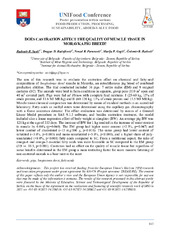Приказ основних података о документу
Does castration affect the quality of muscle tissue in moravka pig breed?
| dc.creator | Savić, Radomir | |
| dc.creator | Radojković, Dragan | |
| dc.creator | Parunović, Nenad | |
| dc.creator | Gogić, Marija | |
| dc.creator | Radović, Čedomir | |
| dc.date.accessioned | 2021-12-31T06:45:46Z | |
| dc.date.available | 2021-12-31T06:45:46Z | |
| dc.date.issued | 2021-09 | |
| dc.identifier.isbn | 978-86-7522-066-4 | |
| dc.identifier.uri | http://r.istocar.bg.ac.rs/handle/123456789/777 | |
| dc.description.abstract | The aim of this research was to evaluate the castration effect on chemical and fatty-acid compositions of longissimus dorsi muscle in Moravka, an autochthonous pig breed of combined production abilities. The trial conducted included 16 pigs: 7 entire males (EM) and 9 surgical castrates (SC). The animals were bred in farm conditions in separate, group pens (110 m2 open and 40 m2 covered part). Pigs were fed ad libitum with complete feed mixtures: I (25-60 kg, 15% of crude protein, and 13.6 MJ ME/kg) and II (60-120 kg, 13% of crude protein and 13.5 MJ ME/kg). Muscle tissue chemical composition was determined by means of standard methods in an accredited laboratory. Fatty acids as methyl esters were determined using the capillary gas chromatography with a flame ionization detector. The effect evaluation was determined by means of a General Linear Model procedure in SAS 9.1.3 software, and besides castration treatment, the model included also a linear regression effect of body weight at slaughter (BW). An average pig BW was 121 kg at the age of 333 days. The increase of BW for 1 kg resulted in the increase of water content in muscle by 0.06% (p=0.040). The EM group had higher water content (+2.3%, p=0.047) and lower content of cholesterol (−15 mg/100 g, p=0.031). The same group had lower content of saturated (−3.6%, p=0.003) and mono-unsaturated (−5.6%, p<0.001), and a higher share of polyunsaturated (+9.0%, p<0.001) fatty acids compared to SC. From a nutritional aspect, the ratio of omega-6 and omega-3 essential fatty acids was more favorable in SC compared to the EM group (3.9 vs. 18.5, p<0.001). Castration had an effect on the quality of muscle tissue but regardless of some benefits determined in the EM group a main restricting factor for more massive fattening of non-castrated animals is a boar taint in the meat. | sr |
| dc.language.iso | en | sr |
| dc.publisher | University of Belgrade | sr |
| dc.relation | info:eu-repo/grantAgreement/MESTD/inst-2020/200022/RS// | sr |
| dc.relation | info:eu-repo/grantAgreement/MESTD/inst-2020/200116/RS// | sr |
| dc.relation | info:eu-repo/grantAgreement/MESTD/inst-2020/200050/RS// | sr |
| dc.relation | info:eu-repo/grantAgreement/EC/H2020/634476/EU// | sr |
| dc.rights | openAccess | sr |
| dc.rights.uri | https://creativecommons.org/licenses/by/4.0/ | |
| dc.source | Book of abstracts of the 2nd International UNIFood Conference, 24th-25th September 2021 | sr |
| dc.subject | pigs | sr |
| dc.subject | longissimus dorsi | sr |
| dc.subject | fatty acids | sr |
| dc.title | Does castration affect the quality of muscle tissue in moravka pig breed? | sr |
| dc.type | conferenceObject | sr |
| dc.rights.license | BY | sr |
| dc.citation.spage | 143 | |
| dc.identifier.rcub | https://hdl.handle.net/21.15107/rcub_ristocar_777 | |
| dc.identifier.fulltext | http://r.istocar.bg.ac.rs/bitstream/id/4012/bitstream_4012.pdf | |
| dc.type.version | publishedVersion | sr |


